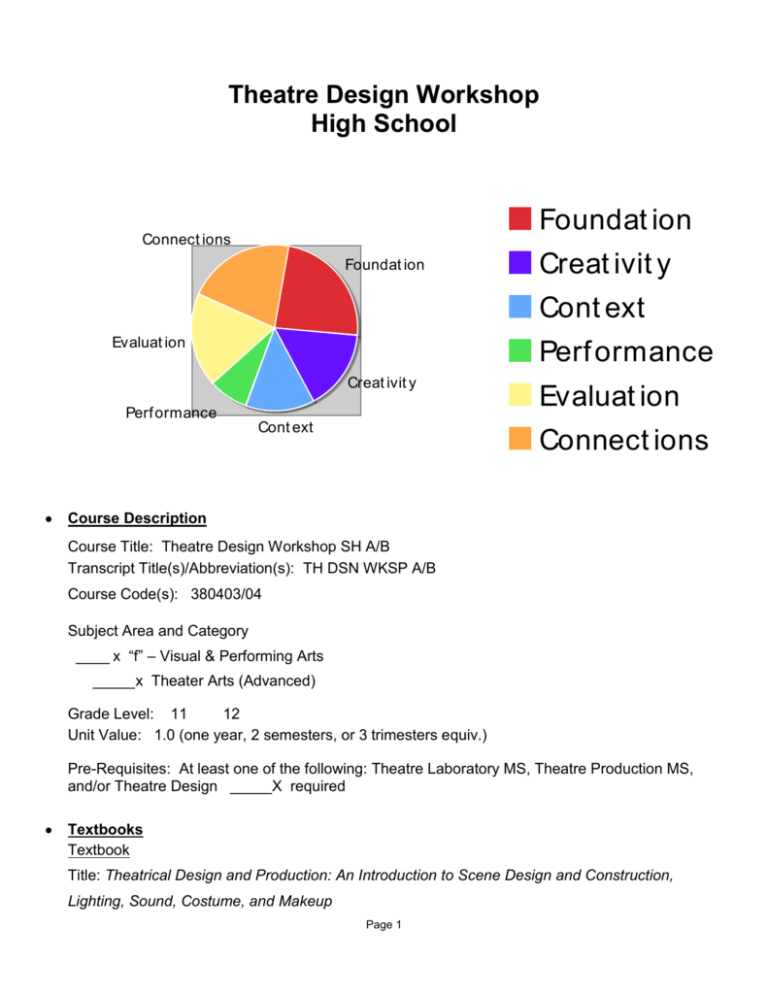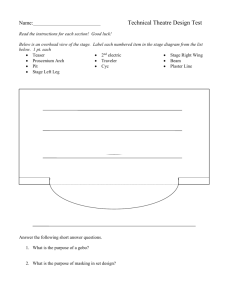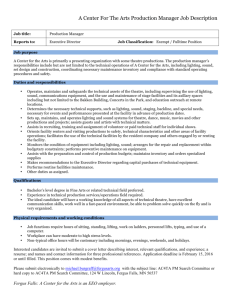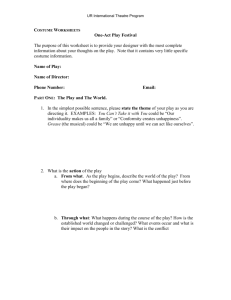Design Workshop SH A/B
advertisement

Theatre Design Workshop High School Foundat ion Connect ions Foundat ion Creat ivit y Cont ext Evaluat ion Perf ormance Creat ivit y Perf ormance Cont ext Evaluat ion Connect ions Course Description Course Title: Theatre Design Workshop SH A/B Transcript Title(s)/Abbreviation(s): TH DSN WKSP A/B Course Code(s): 380403/04 Subject Area and Category ____ x “f” – Visual & Performing Arts _____ x Theater Arts (Advanced) Grade Level: 11 12 Unit Value: 1.0 (one year, 2 semesters, or 3 trimesters equiv.) Pre-Requisites: At least one of the following: Theatre Laboratory MS, Theatre Production MS, and/or Theatre Design _____X required Textbooks Textbook Title: Theatrical Design and Production: An Introduction to Scene Design and Construction, Lighting, Sound, Costume, and Makeup Page 1 Edition: 5th Publication Date: 2007 Publisher: McGraw-Hill Author(s): J. Michael Gillette Usage: ___ x Primary Text __ Read in entirety or near entirety Course Content Course Purpose: Theatre Design Workshop is an interdisciplinary course, addressing standards and topics from theatre, visual arts, stagecraft, and media arts. It is a foundation course for students who wish to consider a career in technical theatre design and production. This course provides comprehensive production design instruction for intermediate theatre students. Aspects of stagecraft and design applications will be explored in connection with the study of theatre literature, music and dance performance and the production of a fully staged public performance of a musical or dramatic work. Students will be required to talk and write with discrimination about the artistic material under production and to undertake relevant outside-of-class research, reading and writing, in addition to performance preparation. Students will develop their understanding of theatre design and production as collaborative arts, uniting visual and performing arts. Students will explore questions such as: Is it more important to know why a design works, or what works in a design? Is there a difference? Course Outline: I. Design Concepts and Play Analysis A. Significant Designers through History will be researched such as Inigo Jones, David Belasco, Adolph Appia, Edward Gordon Craig, Jo Mielziner and Oliver Smith; results will be shared with the class B. Compare One Play Done Several Ways such as a Shakespearean play done in Elizabethan style, in a contemporary style and in a futuristic style, noting ways in which this was achieved through design elements. Present findings in a media presentation such as video or power point C. Analysis and Design study will focus on determining how and why designers make aesthetic choices relevant to the playwright’s intent; a written critical analysis will be completed II. Industrial Materials for Scenery A. Research New Materials such as plastics, foam, projections B. Develop Sources for materials; prepare a list of vendors and research sites III. Construction Tool Use and Safety A. Stocking the Shop B. Safety Issues IV. Makeup Design and Techniques A. History of Makeup Design will be researched to include such designers as Irene Corey, Max Factor, Ludwig Leichner and Leman Thomas Rede and styles such as realism, Kabuki, Peking Opera; results will be shared with the class B. Application Techniques will be demonstrated and practiced Page 2 C. Corrective Makeup techniques will be demonstrated and practiced D. Character Makeup will be researched, demonstrated and practiced V. Costume Design and Construction A. Period Costumes will be studied and connected to specific productions such as Greek, Medieval, Commedia, Elizabethan, Restoration B. Contemporary Costumes will be researched and discussed C. Buy or Build strategies will be studied for most efficient results D. Fabric Selection will be researched and practiced E. Construction Techniques will be practiced such as pattern making, sewing, draping F. Significant costume designers will be researched such as Robert Edmund Jones, Theoni Aldredge, Bob Mackie, Julie Taymor, Jane Greenwood, Susan Hilferty, Edith Head and John Napier; results will be shared with the class VI. Lighting and Sound Applications A. Significant Designers will be studied such as Robert Edmund Jones, Tharon Musser, Kliegl Brothers, Charles Macready, Norman Bel Geddes, Jean Rosenthal, Jules Fisher, Jennifer Tipton, Luigi Russolo, Walter Murch, Dan Dugan, Charlie Richmond, John Gromada; research results will be shared with the class B. Current Trends in lighting and sound will be introduced, discussed and practiced such as digital projections, computer generated video and audio, musical composition C. Analysis of Effect on Mood will be studied by viewing productions and analyzing how feelings and moods are established through design; written analyses will be completed VII. Scenic Painting A. Significant Scene Painters will be researched such as Aleksander Jendov, David Hockney, Georgi Popovjhon, Salvador Dali, Abdelkader Farrah and William Strickland; results will be shared with the class B. Principles of Color will be studied and discussed by looking at a variety of set designs from various periods and styles C. Painting Techniques will be studied and practiced 1. Forced Perspective will be demonstrated and practiced 2. Texturing techniques will be presented and practiced 3. Faux Finishes will be studied and practiced VIII. Advertising Design Strategies A. Promotion Strategies will be researched and shared with the class focusing on advertisers such as Tara Biek Creative of Stuart, Dewysters, SpotCo, Allied Live and 321 Theatrical Management B. Computer Graphics uses will be researched and practiced IX. Stage Management A. Organization of production elements such as rehearsal schedules, director’s blocking, technical cues is studied and practiced B. Working with Actors and Directors is discussed, practiced and refined C. Running a Show is practiced Key Assignments: Design and apply the sets, costumes, makeup, properties, sound, and lighting for effective interpretation of a script. Write an analysis of why the selected design elements were chosen. Include an analysis of the period or style chosen. Page 3 Film scenes and edit video incorporating sound effects and background music that obey and correspond to the writer’s or director’s artistic vision. Scenes are from a variety of periods and styles. Participate fully in a theatre-related designer/technician role (e.g. carpentry, lighting/sound, costuming/props, running crew, make up, stage management) in a performance before a live audience in a final production. Keep a daily journal reflecting on your learning and application of that learning. Complete a research paper on a chosen style of production; compare and contrast several designers who incorporate that style and present your findings to the class. Write three critiques of productions viewed, focusing on the design elements. Each production should be from a different period or style. Compile all papers, designs, research into a portfolio. Instructional Methods and/or Strategies: Viewing Productions Direct Instruction Discussion Group Planning Research Journaling Creating Productions Portfolio Preparation Assessments Including Methods and/or Tools: Review research projects for depth of understanding of the field of stage design. Journals provide an on-going record of progress in design work and of personal relationship to the work. Observation of planning, preparation and execution of projects will show student understanding of design principles as well as ability to communicate ideas. Rubrics will be applied to all student work. Portfolio will include designs, rubrics, research papers; they will show student growth. Artistic Perception: Use appropriate theatre vocabulary to respond to productions in terms of acting values, style, genre, design and theme. Demonstrate an understanding of form and content in theatre. Use appropriate theatre terminology to describe how the following are used to convey an idea or emotion in theatre: form, setting, style, theme, visual/design elements, movement, Page 4 and vocal elements. Apply technical vocabulary to acting and production problems. Compare a traditional interpretation of a play with a non-traditional interpretation and defend the merits of the different interpretations. Creative Expression: Demonstrate an insightful understanding of works in theatre by analyzing and interpreting through voice, movement, and visual effects in informal productions, theatrical productions, films and electronic media. Apply a high degree of sensory awareness to artistic direction. Demonstrate an understanding of the professional standards of the actor, director, scriptwriter, and technical artist. Maintain an annotated rehearsal text and/or playbook showing technical cues for lighting and sound. Demonstrate the use of two different technologies to make formal and informal presentations. Historical and Cultural Context: Identify and compare how film, theatre, television and electronic media productions influence our lives and behaviors. Demonstrate an understanding of how fashion, religion and social conventions affect clothing and make-up through the ages. Design sets, costumes, properties, lighting or makeup for scenes from a variety of cultures or historical periods. Aesthetic Valuing: Document observations and evaluate perception values (i.e. lighting, mood, color, atmosphere, and sound) through class discussion and in reflective writing using theatre vocabulary. Analyze and make informed judgments about theatre on the basis of form, content, technique and creativity. Evaluate critically all aspects of a school production, including acting, technical business, and public relations responsibilities. Write a critical review of a play, musical CD, art exhibition. Connections, Relationships, and Applications: Manage time, prioritize responsibilities, and meet completion deadlines for a production Page 5 as specified by group leaders, team members, or directors. Demonstrate an understanding of how to apply a variety of technological tools in other subject areas. Identify multiple career opportunities in theatre. Create alternative solutions using critical and creative thinking skills, logical reasoning, analytical thinking, and problem solving techniques. Common Core State Standards: See Guiding Principles for connections. Credentials required to teach this course: One of the following: General Secondary Special Secondary English Standard Secondary with major/minor English Standard Secondary with major/minor Drama Single Subject English Subject Matter Authorization Drama/Theatre Supplementary Authorization Drama Page 6






